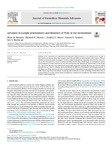| dc.description.abstract | Pollution of the environment by polychlorinated biphenyls (PCBs) continues to be a global concern because of
their toxicity, persistence, long-range transport properties and ability to bioaccumulate in fatty tissues. PCBs are
classified as ’probable human carcinogens’ as well as endocrine-disrupting compounds, and, therefore, their presence in the environment is a threat to human and animal health. Their monitoring in the environment requires
novel techniques to achieve detection at very low concentrations that demonstrate harmful effects to the ecosystem. This review discusses conventional and novel sample preparation methods that make use of novel sorbent
materials that are aimed at reducing matrix interferences in different environmental and biological matrices. It
also focuses on advancements in detection techniques aimed at high selectivity and sensitivity, and low detection
limits. These range from conventional chromatographic techniques to sensor technology that facilitates the detection of PCBs at very low concentrations prompting the attainment of cost-effective and reliable methods that
promote routine monitoring. | en_US |

